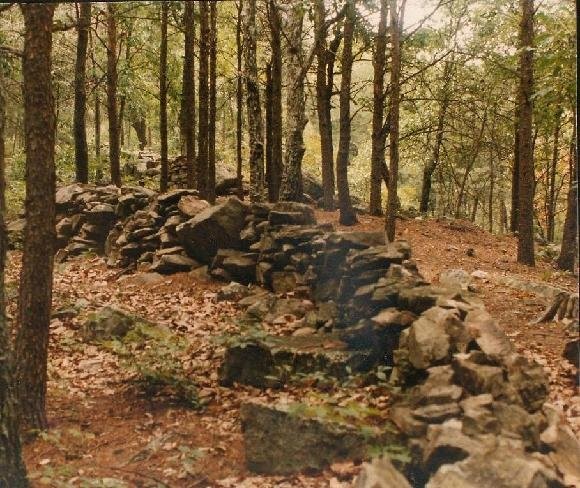Dug Gap Battle Park
Introduction
Text-to-speech Audio
This Georgia State Park preserves a battlefield and defensive fortifications that were constructed by Confederate soldiers in 1863. Although outnumbered, Confederate soldiers had five months to build defensive fortifications before Union soldiers attacked in February 1864 and again on May 8, 1864. The park includes some of the Confederate defenses, including 1200 feet a massive stone wall that was used both for protection and as a weapon. As Union soldiers advanced, Confederate defenders pushed portions of the wall and other boulders down on the advancing Union troops. By holding the high position in the gap between Dalton and Lafayette, Confederate soldiers were able to fire down on Union soldiers in addition to rolling the stones down the steep incline. Despite being outnumbered, the Confederates held the field owing to superior position and preparation. Visitors to the park can use a variety of hiking trails to see some of the original Confederate defenses.
Images
The rock wall formation as it is seen today if you would visit the park

The marker that details the background of the battlefield site

Backstory and Context
Text-to-speech Audio
The park is the site of an unusual battle during the Civil War that saw outnumbered Confederates use boulders to thwart a Union offensive. Confederate troops led by Colonel J.A. Williamson built defenses and a massive wall in 1863 that afforded a smaller force protection from Union bullets and also became a weapon against advancing Union soldiers the following year. The Union had already secured Dalton and was advancing toward Lafayette.
Confederate troops from Arkansas would hold off Union forces at this location twice in 1864. The first attempt was in February of 1864 and the second attack came in May of 1864. The first attempt was quick and an easy victory for the Confederate soldiers who used the rock wall as a shield from the Union bullets. Union soldiers retreated but would return back again months later.
The second attempt saw Union troops under General Geary clash with Confederate troops led by General Williamson and Grisby. The Union might have prevailed, but Confederate reinforcements paired with superior position led the Union troops without cover from the fire along the mountainside. Confederate soldiers on top of the hill covered by the defensive rock formations. Confederates also used their boulders and wall as a weapon, pushing the large stones down the steep hill killing or injuring Union soldiers. The Union soldiers retreated and maneuvered away from the well-defended area.
A large portion of the rock formation has been largely preserved. Although it is much smaller than it was in the battle, the rock wall formation is available for hikers and maintained by the Civil War Round Table of Dalton.
Confederate troops from Arkansas would hold off Union forces at this location twice in 1864. The first attempt was in February of 1864 and the second attack came in May of 1864. The first attempt was quick and an easy victory for the Confederate soldiers who used the rock wall as a shield from the Union bullets. Union soldiers retreated but would return back again months later.
The second attempt saw Union troops under General Geary clash with Confederate troops led by General Williamson and Grisby. The Union might have prevailed, but Confederate reinforcements paired with superior position led the Union troops without cover from the fire along the mountainside. Confederate soldiers on top of the hill covered by the defensive rock formations. Confederates also used their boulders and wall as a weapon, pushing the large stones down the steep hill killing or injuring Union soldiers. The Union soldiers retreated and maneuvered away from the well-defended area.
A large portion of the rock formation has been largely preserved. Although it is much smaller than it was in the battle, the rock wall formation is available for hikers and maintained by the Civil War Round Table of Dalton.
Sources
Sowder, Marvin. Dug Gap Battle Park. National Geographic. October 15, 2012. Accessed September 17, 2018. https://www.tennesseerivervalleygeotourism.org/content/dug-gap-battle-park/tenc00024ea87e450984.
Campi, Jim. Battle of Dug Gap - May 8, 1864. American Battlefield Trust. . Accessed September 17, 2018. https://www.battlefields.org/learn/maps/battle-dug-gap-may-8-1864.
Dug Mountain. SummitPost. November 22, 2007. Accessed September 17, 2018. https://www.summitpost.org/dug-mountain/359122.
Campi, Jim. Battle of Dug Gap - May 8, 1864. American Battlefield Trust. . Accessed September 17, 2018. https://www.battlefields.org/learn/maps/battle-dug-gap-may-8-1864.
Dug Mountain. SummitPost. November 22, 2007. Accessed September 17, 2018. https://www.summitpost.org/dug-mountain/359122.
